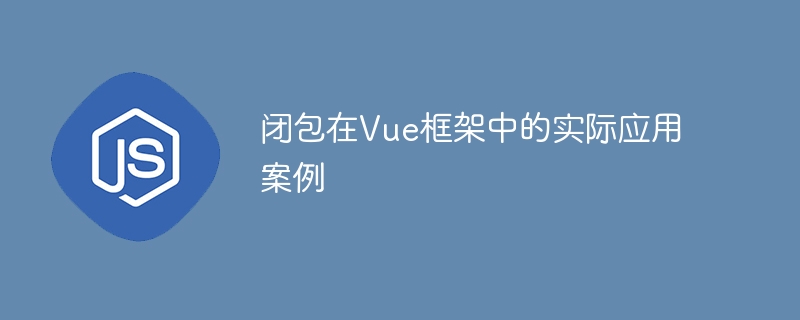Home >Web Front-end >JS Tutorial >Case analysis of using closures for instances in the Vue framework
Case analysis of using closures for instances in the Vue framework
- WBOYWBOYWBOYWBOYWBOYWBOYWBOYWBOYWBOYWBOYWBOYWBOYWBOriginal
- 2024-01-13 14:22:061151browse

Practical application cases of closures in the Vue framework
In the Vue framework, closures are a powerful concept that can be used to create private variables and methods, and implement functions such as encapsulation and inheritance. In this article, we will introduce some concrete examples to show the practical application of closures in the Vue framework.
- Private variables and methods
In the Vue framework, we usually need to create private variables and methods to encapsulate and protect data. Closures provide a concise and efficient way to achieve this.
Vue.component('private-component', (function() {
let privateVariable = '私有变量';
function privateMethod() {
console.log('私有方法');
}
return {
template: `
<div>
<p>{{ privateVariable }}</p>
<button @click="privateMethod">调用私有方法</button>
</div>
`,
data() {
return {
privateVariable: privateVariable
};
},
methods: {
privateMethod: privateMethod
}
};
})());In this example, we use an immediately invoked function expression (IIFE) to create a closure in which the private variable privateVariable and the private method privateMethod are defined. We then create a Vue component by returning an object containing the Vue component options. In Vue components, we can access and call private variables and methods.
- Encapsulation and inheritance
Closures can also be used to implement the functions of encapsulation and inheritance. Below is a simple example that shows how to implement a simple encapsulation and inheritance pattern through closures.
function createAnimal(name) {
let privateVariable = '私有变量';
function privateMethod() {
console.log('私有方法');
}
return {
name: name,
speak() {
console.log(`我是${this.name}`);
},
getInfo() {
console.log(privateVariable);
},
callPrivateMethod() {
privateMethod();
}
};
}
let animal = createAnimal('小猫');
animal.speak(); // 输出:我是小猫
animal.getInfo(); // 输出:私有变量
animal.callPrivateMethod(); // 输出:私有方法In this example, we use an ordinary function to create a closure, which defines the private variable privateVariable and the private method privateMethod. We then return an object containing the public methods speak, getInfo, and callPrivateMethod, which can access and call private variables and methods. By creating a closure, we can create an Animal object and use encapsulation to access and call its methods.
Summary:
Closure is a very useful concept and has a wide range of applications in the Vue framework. By using closures, we can create private variables and methods to implement encapsulation and inheritance. In this article, we introduce some practical application cases of closures in the Vue framework and provide specific code examples. I hope these examples can help readers better understand the application of closures in the Vue framework.
The above is the detailed content of Case analysis of using closures for instances in the Vue framework. For more information, please follow other related articles on the PHP Chinese website!
Related articles
See more- An in-depth analysis of the Bootstrap list group component
- Detailed explanation of JavaScript function currying
- Complete example of JS password generation and strength detection (with demo source code download)
- Angularjs integrates WeChat UI (weui)
- How to quickly switch between Traditional Chinese and Simplified Chinese with JavaScript and the trick for websites to support switching between Simplified and Traditional Chinese_javascript skills

